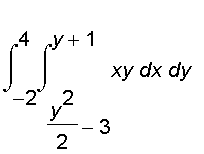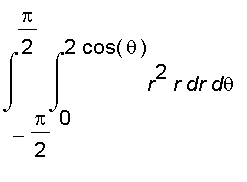¡@
Double Integral Over General Regions
1. Evaluate
, where D is the region bounded by the parabolas
and
.
First, by solving

,
we find the intersections of the parabolas are (
) and (
). Here is the picture if the region D :
![[Maple Plot]](images/doubleInt_general_region8/doubleInt_general_region8_001.jpg)
We see that fix x in [
], y goes from
to
, so we get
=
![int(int([x+2*y],y = 2*x .. 1+x^2),x = -1 .. 1)](images/doubleInt_general_region13.gif)
=
=

We can view the double integral as the volume of the solid bounded by the planes
(colored blue),
and the cylinders
(colored yellow),
(colored green).
![[Maple Plot]](images/doubleInt_general_region21.gif)
3DVIEW3DVIEW
2. Find the volume of the solid that lies under the paraboloid
and above the region D in the xy -plane bounded by the line
and the parabola
.
The solid is bounded by the paraboloid
(colored blue), the plane
(colored yellow), the cylinders
(colored green) and the xy -plane. Here is a picture of the solid :
By solving


we find the intersections of the parabolas are (
) and (
). Here is the picture if the region D :
We see that fix x in [
], y goes from
to
, so we get that the volume equals
=
![int(int([x^2+y^2],y = x^2 .. 2*x),x = 0 .. 2)](images/doubleInt_general_region39.gif)
=
¡@=

3. Evaluate
, where D is the region bounded by the line
and the parabola
.
by solving

,
we find the intersections of the parabolas are (
) and (
). Here is the picture if the region D :
¡@
We see that fix y in [
], x goes from
to
, so
=

=

=

We can view the double integral as the "signed volume" of the solid bounded by the hyperbolic paraboloid
(colored blue), the cylinders
(colored green), and the planes
(colored yellow) and
(colored pink).
4. Find the volume of the tetrahedron bounded by the planes
,
,
, and
.
The vertices of the tetrahedron are (
), (
), (
) and (
).
The volume of the tetrahedron is given by
, where D is the region bounded by the lines
and
.
We see that fix x in [
], y goes from
to
, so we get that the volume equals
=
=
=

If we integrate
first, we have to split the iterated integral into two parts :
![[Maple Plot]](images/doubleInt_general_region85/doubleInt_general_region85_001.jpg)
¡@
=
![int(int([2-x-2*y],x = 0 .. 2*y),y = 0 .. 1/2)+int(int([2-x-2*y],x = 0 .. 2-2*y),y = 1/2 .. 1)](images/doubleInt_general_region87.gif)
5. Evaluate the iterated integral
.
If we try to evaluate the integral as it stands, then we need to find the antiderivatives of
. But this is impossible, because
does not have a closed form. So we must change the order of integration.
Note that
=
![[Maple OLE 2.0 Object]](images/doubleInt_general_region92.gif)
where D = {(
) |
,
}.
![[Maple Plot]](images/doubleInt_general_region96/doubleInt_general_region96_001.jpg)
From the animation below, we see an alternative description of D is
D = {(
) |
,
}.
![[Maple Plot]](images/doubleInt_general_region100/doubleInt_general_region100_001.jpg)
Hence, by Fubini's theorem, we have
=
![[Maple OLE 2.0 Object]](images/doubleInt_general_region102.gif)
=
¡@=
=
.
¡@
6. Find the volume of the solid bounded by the plane
and the paraboloid
.
3DVIEW
![[Maple Plot]](images/doubleInt_general_region108.gif)
The volume equals to
, where D is the unit disk
.
![[Maple Plot]](images/doubleInt_general_region111.gif)
In terms of Cartesian coordinates, D is bounded by
and
, so the volume is given by
=
.
However, the iterated integral is rather complicated to compute. Note that D is rather easy to described using polar coordinates, namely,
.
The volume of the solid is
![[Maple OLE 2.0 Object]](images/doubleInt_general_region117.gif)
=
¡@=

7. Find the volume of the solid that lies under the paraboloid
, above the xy -plane, and inside the cylinder
.
![[Maple Plot]](images/doubleInt_general_region123.gif)
The solid lies above the disk D whose boundary circle has equation
, i.e.,
. Its equation in polar coordinates is given by
, where
is in [
].
![[Maple Plot]](images/doubleInt_general_region129/doubleInt_general_region129_001.jpg)
The volume of the solid is
=

=
¡@
=
.
8. Find the volume of the solid that bounded by the paraboloid
, the plane
, the xy -plane, and inside the cylinder
.
The volume of the solid can be computed as
, where
is the volume of solid bounded by the cylinder
,
and
, which is
.
while
is the volume of solid shown below.
By symmetry
is 2 times the volume of the solid that lies above the first quadrant, so
![[Maple OLE 2.0 Object]](images/doubleInt_general_region150.gif)
where R is the region shown below.
![[Maple Plot]](images/doubleInt_general_region151.gif)
Fix
in
,
goes from
to
, and f ix
in
,
goes from
to
. So we have
![[Maple OLE 2.0 Object]](images/doubleInt_general_region162.gif)
=
=

Therefore, the required volume is
.
![[Maple Plot]](images/doubleInt_general_region20.gif)
![[Maple Plot]](images/doubleInt_general_region28.gif)
![[Maple Plot]](images/doubleInt_general_region29.gif)
![[Maple Plot]](images/doubleInt_general_region34/doubleInt_general_region34_001.jpg)
![[Maple Plot]](images/doubleInt_general_region49/doubleInt_general_region49_001.jpg)
![[Maple Plot]](images/doubleInt_general_region62.gif)
![[Maple Plot]](images/doubleInt_general_region63.gif)
![[Maple Plot]](images/doubleInt_general_region72.gif)
![[Maple Plot]](images/doubleInt_general_region76/doubleInt_general_region76_001.jpg)
![int(int([2-x-2*y],y = x/2 .. 1-x/2),x = 0 .. 1)](images/doubleInt_general_region81.gif)
![[Maple Plot]](images/doubleInt_general_region122.gif)
![[Maple Plot]](images/doubleInt_general_region138.gif)
![[Maple Plot]](images/doubleInt_general_region139.gif)
![[Maple Plot]](images/doubleInt_general_region146.gif)
![[Maple Plot]](images/doubleInt_general_region148.gif)